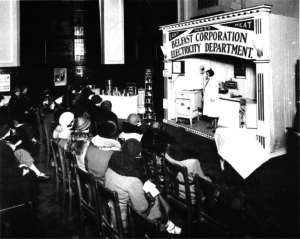Digital Transformation is how an organisation becomes built to continually change, innovate and reinvent rather than simply enhance or support the traditional methods of its industry. The word ‘digital’ is a synonym for the pace of change occurring in today’s world, driven by the rapid adoption of technology.
The concept of technology in digital transformation is an important one but there is a great deal of conflicting opinion surrounding this relationship. In fact, one of the most pervasive digital transformation myths is that technology creates competitive advantage. We strongly disagree.
Columbia University Professor, David Rogers puts it particularly elegantly: “Digital transformation is not about the application of new technology, it’s really about strategy, leadership and new ways of thinking”.
To illustrate the point, let us for a brief moment take a peek into the actually not so dim and distant past when electricity first made its way into domestic use.

This photo taken in the 1930s depicts a group of ladies attending a conference on the use of electricity in the home. (Did you notice that electric heating clearly wasn’t one of the first gadgets invented judging by the proliferation of those rather fabulous fur scarves). We can draw a parallel between the adoption of electricity in the 1930s and technology adoption today.
Bringing electricity into the home did not change the game. The game changed because we could now use machines to perform our tasks at home. Suddenly we could plug in a washing machine. We welcomed electricity into our homes with open arms because it allowed us to use labour saving devices. These machines could perform tasks with greater efficiency than we could carry out manually. We never think about electricity any more (until the power goes off). We care about the gadgets we use to simplify or enrich our lives. It is the same with technology. The gadgetry is not the point, it’s what you do with it that matters.
Technology is not only evolving at a rate that we have never witnessed before, but also in a direction that is moving the power back to the customer. That power comes from choice. Before we all carried devices that connect us to the internet in our back pockets, we selected the most convenient product or service provider. Furthermore, we selected the most affordable or effective solution to meet our needs. The core underlying principles governing that choice haven’t changed. Customers are still trying to perform tasks. The provider we are mostly likely to choose is the one that has the most affordable, effective and convenient solution at the point of need.
This brings us neatly (we hope) to the crux of our argument. Digital Transformation may be powered by technology, but adopting or creating new technology does not lead to digital transformation. Strategy dictates the direction of travel. Technology provides the mode of transport to get you there.
We believe that the underlying principles of digital transformation are:
Strategy creates competitive advantage
People and a culture of innovation sustains it.
Marketing and technology are the means by which it is delivered.
Would you like to know more about digital transformation? We have a created a range of learning resources. Visit our Guides and Case Studies for more.
Do you have any thoughts about this video, why not get in touch and let us know what you’re thinking?


